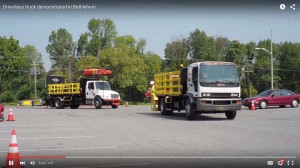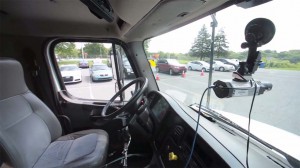The first fully driverless vehicle to hit U.S. highways is going to be a truck, not a car. And it will likely be found slowly rolling around near construction sites in Florida.
Developed by Royal Truck & Equipment, a specialty vehicle manufacturer based near Bethlehem, Pennsylvania, the trucks will be fitted with special devices, called attenuators, designed to protect workers as well as motorists trying to navigate through temporary work zones.
Attenuators are designed to provide a rolling crash barrier, but while that can save construction workers, as well as motorists, they put at risk the people that drive the trucks. So, Royal Truck has developed a system that can be operated autonomously.
“Any time a driver can be removed from these vehicles in a very dangerous situation, and if the vehicle’s struck, there’s nobody inside of it to receive the damage or the injuries, that’s measuring success,” said Robert Roy, president of Royal Truck.
(Apple hires autonomous driving engineer from Tesla, adds to evidence Apple will build driverless electric vehicle. Click Here for more.)
While it’s common to use a truck with warning lights to guide motorists around a rolling work zone, such as a pothole patching crew, motorists occasionally fail to react in time and can slam into the truck. That’s where attenuators come in. They are fitted with a portable crash barrier that can reduce injuries to a motorist, while they have been credited with cutting work-zone injuries and fatalities from rear-end crashes nearly in half, according to a new study by the Journal of the Transportation Research Board.
“Connected and autonomous vehicles in general are viewed as the future of surface transportation, and this technology may be one of the first ways in which it gets commercialized,” study author Gerald Ullman, of the Texas A&M Transportation Institute told the Associated Press.
Most major automakers, as well as upstart Tesla Motors and tech giant Google, are working on autonomous vehicle technology. Tesla expects to launch its Pilot system later this year allowing motorists to drive hands-free on well-marked highways. Nissan has promised to have its first fully autonomous vehicle in production by 2020.
Meanwhile, Daimler AG’s Freightliner subsidiary recently demonstrated its first semi-autonomous 18-wheeler, a prototype 70,000-pound truck that, like the Tesla Model S, is capable of driving hands-free on well-marked roads.
(For more on the autonomous Freightliner Inspiration, Click Here.)
The general consensus is that autonomous technology will initially require a motorist to remain behind the wheel of a vehicle, ready to take control in an emergency. But the attenuator truck developed by Royal would be completely unmanned, reducing the possibility a driver might be injured in a crash.
Royal’s system was developed in cooperation with Micro Systems Inc., a Florida firm that is already supplying unmanned vehicles to the military. The autonomous attenuator truck uses a lead-and-follow system. In a demonstration, it closely mimicked the movements of another truck that would operate at the head of a convoy.
The first of the autonomous attenuator trucks is expected to go into operation in Florida later this year as part of a pilot program run by the Sunshine State’s transportation department.
(Could BMW partner with Apple to build an autonomous car? For more, Click Here.)



If the system has all of the proper failsafe designs and limp mode processes to compensate for computer crashing, it may prove useful. If any safety issue has been overlooked or ignored this could be a major setback for all. As an example what does the AV when the lead truck suddenly swerves into the ditch to avoid an oncoming runaway car? Does the AV follow the lead truck and run over workers instead of stopping dead in the road or slowly pulling to the shoulder?
Will they be hack proof?
Not likely… Have you seen the work zone signs that hackers alter with weird messages? If the proper security and safety measures are not paramount in the designs of these and other AVs, you should already know what the outcome is going to be.
Fifteen years ago the US military was using a system that had a h7man driver in the lead and the vehicle following no driver. These were supply on ans off road oskosh type hauling 20 foot containers on the back end and self loading. The ones following the lead vehicle followed exactly in the other lead vehicle tracks like on rails. It allowed 1 one person to drive up to I believe 5 vehicles at once. Depending on battlefield conditions this reduced personel exposure to snipers ieds etc. Sometimes following exactly is good. One miltary officer pointed out that it was a very long trailer. And thats the reason for restricted access to freeways, so that nothing wanders on to the roadway.